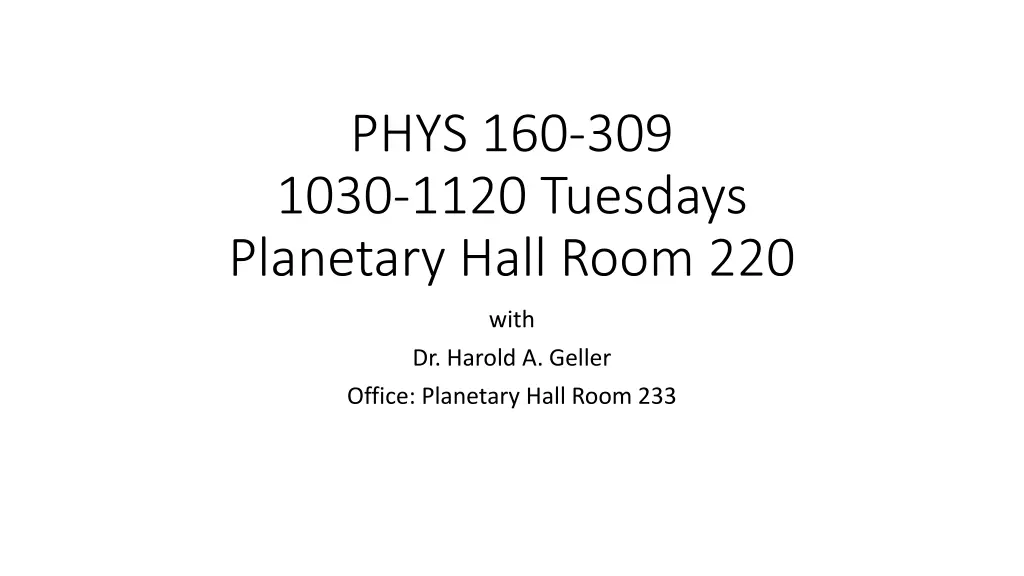
Succeed in PHYS 160 Recitation Session - Tips, Grading, and Questions
Enhance your physics understanding with Dr. Geller's recitation session for PHYS 160. Learn problem-solving tips, grading criteria, and participate in interactive iClicker questions. Join to excel in your physics journey.
Download Presentation

Please find below an Image/Link to download the presentation.
The content on the website is provided AS IS for your information and personal use only. It may not be sold, licensed, or shared on other websites without obtaining consent from the author. If you encounter any issues during the download, it is possible that the publisher has removed the file from their server.
You are allowed to download the files provided on this website for personal or commercial use, subject to the condition that they are used lawfully. All files are the property of their respective owners.
The content on the website is provided AS IS for your information and personal use only. It may not be sold, licensed, or shared on other websites without obtaining consent from the author.
E N D
Presentation Transcript
PHYS 160-309 1030-1120 Tuesdays Planetary Hall Room 220 with Dr. Harold A. Geller Office: Planetary Hall Room 233
Purpose of This Recitation Purpose of This Recitation Help you succeed in PHYS 160 Help you solve problems like you will see on the exams Help you understand the physics concepts
How You Will Be Graded in This Recitation Attendance 70 % Homework presentation (at least one) 15 % Class participation 15 %
Modified Tips for Solving Numerical Problems Look at what is given; list them Look at what it is you wish to find; list that Examine the equations available; list appropriate equation(s) Substitute values and units (dimensional analysis) into the equations Do the mathematics Display the answer clearly using the appropriate units and to the correct number of significant figures Remember that if the answer is a vector quantity, you need to include the direction
iClicker Question Where do you sit in lecture room during the lecture? A Front half of class B Back half of class
iClicker Question Can you see and hear the lecturer? A Yes B No
iClicker Question How are you using BlackBoard? A Homework problems B PowerPoint slides C Access to textbook D Both A and B above E A, B and C above
iClicker Question Which term identifies a scalar quantity? A displacement B momentum C velocity D time
iClicker Question Which term identifies a scalar quantity? A displacement B momentum C velocity D time
iClicker Question Two 20-Newton forces act concurrently on an object. What angle between these forces will produce a resultant force with the greatest magnitude? A 0o B 45o C 90o D 180o E 360o
iClicker Question Two 20-Newton forces act concurrently on an object. What angle between these forces will produce a resultant force with the greatest magnitude? A 0o B 45o C 90o D 180o E 360o
iClicker Question A car travelling west in a straight line on a highway decreases its speed from 30.0 meters per second to 23.0 meters per second in 2.00 seconds. The car s average acceleration during this time interval is A 3.5 m/s2east B 3.5 m/s2west C 13 m/s2east D 13 m/s2west
iClicker Question A car travelling west in a straight line on a highway decreases its speed from 30.0 meters per second to 23.0 meters per second in 2.00 seconds. The car s average acceleration during this time interval is A 3.5 m/s2east B 3.5 m/s2west C 13 m/s2east D 13 m/s2west
iClicker Question In a race, a runner traveled 12 meters in 4.0 seconds as she accelerated uniformly from rest. The magnitude of the acceleration of the runner was A 0.25 m/s2 B 1.5 m/s2 C 3.0 m/s2 D 48 m/s2 E 0.3 m/s2
iClicker Question In a race, a runner traveled 12 meters in 4.0 seconds as she accelerated uniformly from rest. The magnitude of the acceleration of the runner was A 0.25 m/s2 B 1.5 m/s2 C 3.0 m/s2 D 48 m/s2 E 0.3 m/s2
iClicker Question A projectile is launched at an angle above the ground. The horizontal component of the projectile s velocity, vx, is initially 40 meters per second. The vertical component of the projectile s velocity, vy, is initially 30 meters per second. What are the components of the projectile s velocity after 2.0 seconds of flight? [Neglect air resistance.] A vx= 40 m/s and vy= 10 m/s B vx= 40 m/s and vy= 30 m/s C vx= 20 m/s and vy= 10 m/s D vx= 20 m/s and vy= 30 m/s
iClicker Question A projectile is launched at an angle above the ground. The horizontal component of the projectile s velocity, vx, is initially 40 meters per second. The vertical component of the projectile s velocity, vy, is initially 30 meters per second. What are the components of the projectile s velocity after 2.0 seconds of flight? [Neglect air resistance.] A vx= 40 m/s and vy= 10 m/s B vx= 40 m/s and vy= 30 m/s C vx= 20 m/s and vy= 10 m/s D vx= 20 m/s and vy= 30 m/s
iClicker Question A ball is thrown with an initial speed of 10 meters per second. At what angle above the horizontal should the ball be thrown to reach the greatest height? A 0o B 30o C 45o D 90o E 180o
iClicker Question A ball is thrown with an initial speed of 10 meters per second. At what angle above the horizontal should the ball be thrown to reach the greatest height? A 0o B 30o C 45o D 90o E 180o
Formulas Available for First Exam (expected)
